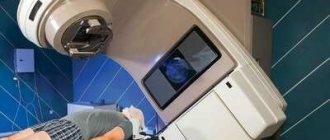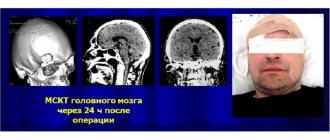Medulloblastoma is a malignant brain tumor located in the cerebellar hemispheres, but most often the location of medulloblastoma is the cerebellar vermis.
It primarily affects children under 10 years of age; there are rare cases of this tumor in adults.
Features of medulloblastoma: in children it is a common tumor among brain cancers; childhood medulloblastoma is characterized by rapid growth and metastasis. Medulloblastoma is more often diagnosed in boys. In adults, when medulloblastoma is detected, the tumor is usually small in size and practically does not metastasize. A tumor in patients over 20 years of age is a rare occurrence. Perhaps due to the absence of any symptoms.
The causes of this tumor are unknown, but certain risk factors have been identified that increase the likelihood of developing medulloblastoma:
- Viral infections (herpes virus, cytomegalovirus, infectious mononucleosis).
- Genetic diseases that often accompany medulloblastoma (Gorlin-Goltz syndrome, Maffucci syndrome, Turcot syndrome, Cowden disease).
- Ionizing radiation.
- Carcinogens (food, household).
Symptoms
With further growth, the tumor grows into the cavity of the fourth ventricle, which can lead to closure of the spinal canal and disrupt the outflow of cerebrospinal fluid. When growing into the brain stem, the medulla oblongata, where the corresponding centers that regulate many functions in the body are located, the tumor leads to a clear clinical picture, which depends on which structures the tumor affects.
This may be developed strabismus in a child, nystagmus, severe headaches, nausea, vomiting, and swallowing problems. Depending on the growth of the tumor, the presence of metastases and closure of the spinal canal, the symptoms of medulloblastoma are characterized by hydrocephalus or hydrocephalus of the brain. In infants and children of the first year of life, due to these processes, the size of the head increases.
One of the first signs of medulloblastoma may be ataxia (cerebellar disorder), that is, imbalance when walking, unsteadiness of gait. Small children may refuse to walk, crawl, or ask to be held.
Symptoms of medulloblastoma
The symptoms of the disease are determined by several factors: the localization of the tumor, the severity of the cerebral syndrome, the location of metastases and their extent. In 80% of cases, medulloblastoma is localized in the cerebellum, which provokes the development of cerebellar ataxia. This pathology is characterized by the formation of a cerebellar gait - the patient is forced to walk with his legs apart and balancing with his hands so as not to accidentally fall.
Since the patient's coordination of movements is impaired, he falls very often, especially when making turns. If the tumor begins to deepen into the brain stem, the patient’s well-being deteriorates sharply, as geodynamic and respiratory disorders begin to appear. The results of assessing the patient’s neurological status show gaze paresis, suppression of the pharyngeal reflex, convergence disorder, and spontaneous nystagmus. If the spinal cord joins the pathological process, paralysis of the limbs and sensory impairment may occur.
Patients with medulloblastoma also experience general cerebral symptoms: increased irritability, psychomotor agitation, disorientation in time, place and self. The patient complains of severe headache, vomiting, nausea. In pediatric patients, the symptoms of the disease may not appear immediately, since in children the size of the skull is enlarged, the blood vessels are elastic, and the brain is plastic. Therefore, the diagnosis is usually made very late - only after medulloblastoma has occupied the fourth ventricle of the brain, the worm, and has grown into the bulbar structures.
If medulloblastoma grows and metastases appear, the patient's condition begins to rapidly deteriorate. Unlike other types of brain tumors, medulloblastoma is capable of metastasizing beyond the central nervous system. Namely, patients are found to have metastases in the lungs, bones and liver. The most common and dangerous complication of the disease is hydrocephalus. It appears due to blockage of the outflow of cerebrospinal fluid by a neoplasm, which rapidly increases in size. Clinical manifestations of this pathology will be:
- headache;
- downward displacement of the eyeballs;
- strabismus;
- nystagmus;
- nausea.
Differential diagnosis
It is most common among tumors in children, but before making a final diagnosis, it is necessary to exclude diseases that are similar to medulloblastoma.
Among pediatric pathologies this may be:
- Brain ependymoma is a benign tumor that develops from the cells lining the ventricles of the brain and the spinal cord canal.
- hairy astrocytoma.
- Choroid papilloma.
In adults, these may be cerebellar metastases, ependymoma, choroidpapilloma and hemangioblastoma.
Diagnosis of medulloblastoma in Israel – accuracy exceeds all expectations
Day one – consultation with a doctor
On the first day of the diagnostic process, the doctor conducts a full examination of the patient, collects a complete history of the disease and studies the medical documentation brought by the patient. The diagnostic results, which were carried out in another clinic, are sent for revision to confirm their reliability and sufficient quality. Some studies may not be re-authorized if the quality of their data has been confirmed in the audit and is sufficient for subsequent treatment development.
Day two – diagnostics
Diagnosis is one of the key stages in successful treatment of medulloblastoma. Based on the diagnostic results, a subsequent treatment plan is developed. At the Ichilov Clinic, the patient may be prescribed the following tests:
- blood tests (general, biochemical);
- CT scan – determines the degree of brain damage and disturbances in its functioning;
- PET-MRI – detects the smallest tumor formations ranging in size from several millimeters;
- MRI – allows you to obtain a layer-by-layer image of the brain and identify unnatural formations in its tissues;
- biopsy - to make a final diagnosis and determine the specific subtype of the tumor.
Day three – therapy protocol
The treatment plan for medulloblastoma in Israel is developed by a group of specialists based on the diagnostic results obtained. This is a treatment plan unique in its structure, drawn up for each patient, which takes into account all the features of his tumor and his body. The patient and his companion can be present during the development of the therapy protocol, having the opportunity to understand from the very beginning the reasons for prescribing certain methods.
Diagnostics
If a brain tumor is suspected, a general blood test and biochemistry, consultation with an ophthalmologist with a mandatory fundus examination, neurosonography (NSG) or ultrasound of the brain for infants, children under 3 years of age, CT or MRI to detail the size and location of the brain tumor are mandatory. brain, as well as the spinal cord to exclude metastasis, positron emission tomography (PET) to identify regional and distant metastases.
Carrying out a stereotactic biopsy will help to make a final diagnosis, determine the type of medulloblastoma and develop further, but individual, treatment tactics.
Stereotactic biopsy is performed under general anesthesia and is applied using a stereotactic frame or using neuronavigation. If a stereotactic frame is used, a CT or MRI scan is performed during the operation.
With neuronavigation, MRI and CT are done before surgery, and then at the time of biopsy, a 3D image is made from the pictures. The needle used for biopsy is equipped with a microvideo camera. Everything is done in order to take the desired piece of tissue as accurately as possible and minimize complications after the biopsy. Stereotactic biopsy is a complex operation that requires experience from the doctor.
Treatment of medulloblastoma in Israel is an indisputable result
Chemotherapy. Chemotherapy drugs have a systemic effect on the patient’s body, depriving the tumor of the opportunity to grow and spread metastases. The Ichilov Clinic constantly conducts clinical trials of new formulas of chemotherapy drugs, and each patient can be included in the “experimental treatment” group with personal consent. Doctors at the Ichilov Clinic try to achieve the highest effectiveness of treatment, while reducing the intensity of side effects caused by the death of healthy cells. If high-dose chemotherapy is needed, doctors may combine it with a stem cell transplant. Stem cells are specific cells that underlie the hematopoietic system (hematopoiesis) and contribute to the rapid restoration of healthy cells destroyed due to chemotherapy.
Doctors can partially control the area of effect of cytostatic drugs by changing the methods of their administration. All dosages and combinations of chemotherapy drugs are prescribed based on careful diagnosis and are unique in each specific case. Modern chemotherapy is one of the main methods of treating medulloblastoma in Israel, which does not harm the further development of the child’s brain and prevents relapses of the disease.
Radiation therapy is the impact on tumor formation through high-power ionizing radiation, which destroys abnormal cells and leads to necrosis of the tumor. Radiation therapy at the Ikhilov Clinic is carried out using two methods: contact and remotely. Contact radiation therapy (brachytherapy) involves bringing a radiation source in the form of a special capsule directly to the tumor. The capsule gradually releases radioactive substances that act locally on the tumor. With remote radiation therapy, irradiation is carried out using a special 3 Tesla installation and the latest linear accelerators TrueBeam and Novalis, which allow irradiation only of specified areas of the body without destroying tissue adjacent to the tumor.
In the treatment of medulloblastoma in Israel, radiation therapy makes it possible to consolidate the results of chemotherapy and surgery by destroying the abnormal cells remaining in the tumor bed. Unfortunately, radiation therapy is not used in children under 3 years of age, because any radioactive effect on the brain at such a young age can lead to serious problems in the development of the child.
Surgical removal of medulloblastoma in Israel is carried out by leading neurosurgeons at the Ichilov Clinic, who have performed hundreds of successful operations of this nature. Any brain surgery is performed under the control of modern navigation systems, which reduces the risk of damage to functional areas of the brain to zero. Surgery to treat medulloblastoma does not always remove the tumor completely; sometimes only partial excision is performed and material is collected for subsequent research. Also, during the operation, shunting can be performed, due to which the circulation of cerebrospinal fluid is restored and intracranial pressure is stabilized.
Treatment of medulloblastoma
The surgical treatment method aims to completely remove the tumor; stage-by-stage removal is possible (in several operations or in stages if it was not possible to immediately remove the entire tumor focus). This is what a neurosurgeon does.
After the operation, the child is transferred to oncologists who carry out radiation therapy and chemotherapy. Radiation therapy is carried out for children over 3 years of age; the brain and spinal cord are irradiated to prevent the development of metastases. Chemotherapy is used in complex treatment with other methods, as well as for palliative (making life easier) for the patient.
The approach to each patient is individual and depends on many factors.
Diagnosis of medulloblastoma
To make a diagnosis, the doctor uses the results of comprehensive ophthalmological, neurological and liquorological examinations. Additionally, laboratory tests may also be required: general analysis and biochemical blood tests, general urine analysis.
To identify intracranial hypertension in a patient, the doctor prescribes an ophthalmoscopy. Diagnosis of the disease in children involves the use of neurosonography. To assess the process of metastasis, PET (positron emission tomography) is prescribed. Additionally, a biopsy, determination of tumor markers in the blood, and consultation with a neurosurgeon may be prescribed.
Computed tomography and magnetic resonance imaging are rightfully considered the most reliable methods for diagnosing neoplasms. Both of these diagnostic techniques can detect even the most minor changes in the structure of the patient’s brain.
- CT scan. The results of this study make it possible to identify a tumor that looks like oval or round voluminous neoplasms that heterogeneously accumulate a contrast agent. The doctor also notices that the tumors have displaced the fourth ventricle ventrally. During the examination, it is possible to identify microcalcifications and cysts.
- Magnetic resonance imaging. If the patient has medulloblastoma, this technique is performed in order to identify metastases. During the study, the patient is injected with a contrast agent, which accumulates heterogeneously in different parts of the medulloblastoma. Thanks to the introduction of a contrast agent, it is possible to accurately detect tumor metastasis in the soft meninges of the brain and spinal cord.









